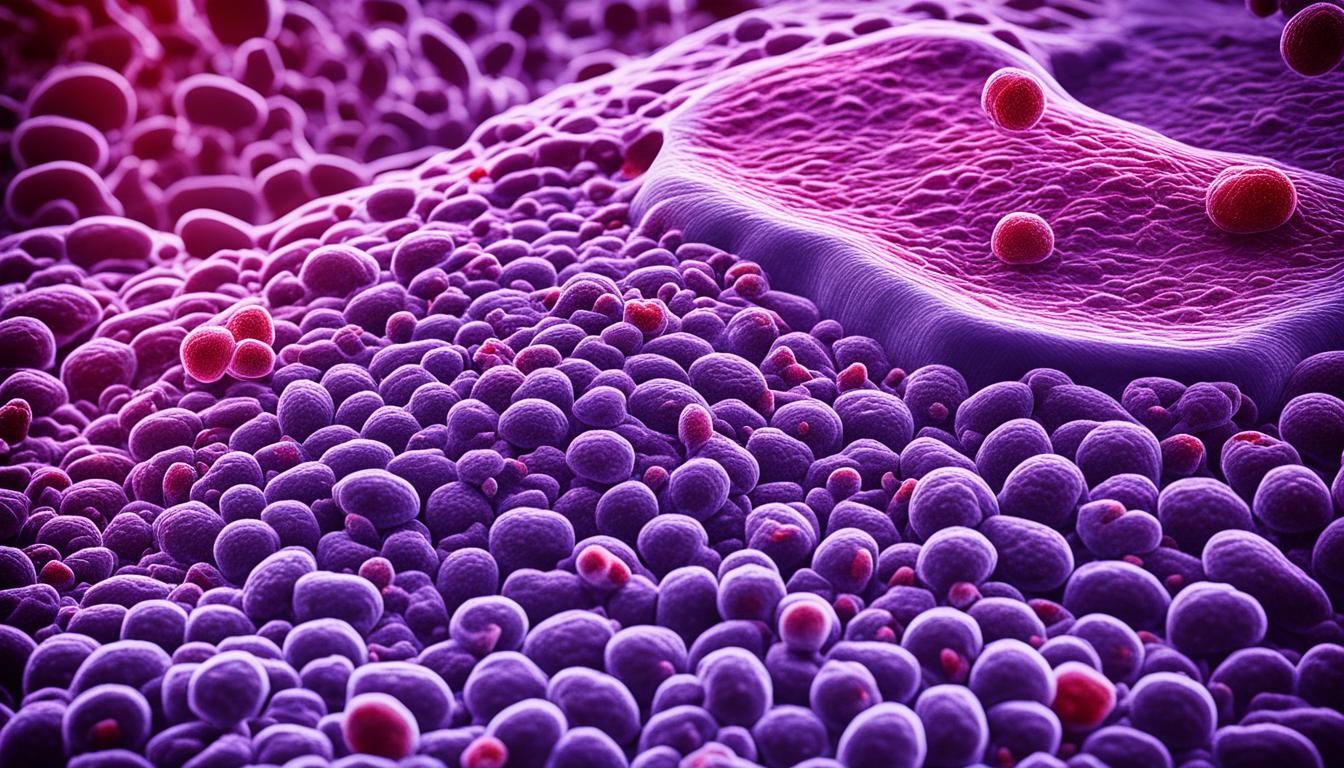MCAD deficiency is a common issue with the body’s ability to use some fats for energy. It mainly appears when someone has not eaten for a while. It’s known as a disorder of mitochondrial fatty acid β-oxidation.
This condition often shows up early in life, with signs like vomiting and feeling tired. Low blood sugar is also a common symptom. Sometimes, it’s not found until later, even in adulthood. Things like not eating or being sick can make these symptoms start.
The root cause of MCAD deficiency is changes in the ACADM gene. These changes stop the medium-chain acyl-CoA dehydrogenase enzyme from working right. Without this enzyme, the body can’t break down fats like it should.
To diagnose MCAD deficiency, doctors use several blood tests. These look at things like iron levels. Then, genetic tests can find the exact gene changes that cause this condition.
The main treatment for MCAD deficiency is to fix low iron levels. This is done by taking iron by mouth or through a vein. Doing this can make the symptoms better and avoid problems.
For some, stem cell therapy might help treat MCAD deficiency. This treatment puts healthy stem cells into the body to replace the bad ones. Researchers are still learning more about this condition to find better treatments.
Key Takeaways:
- MCAD deficiency is the most common inherited disorder of mitochondrial fatty acid β-oxidation in humans.
- Symptoms typically appear during infancy or early childhood, but may also be diagnosed in adulthood.
- MCAD deficiency is caused by mutations in the ACADM gene, affecting the medium-chain acyl-CoA dehydrogenase enzyme.
- Diagnosis involves laboratory tests and genetic testing to identify iron deficiency and specific mutations.
- Treatment options include iron supplementation and potential stem cell therapy.
Diagnosis of MCAD Deficiency
Diagnosing MCAD deficiency involves several tests. These tests help find out if someone has the condition. They also help in knowing the specific DNA changes related to MCAD deficiency.
Laboratory Tests for MCAD Deficiency
Doctors use common tests to diagnose MCAD deficiency. These include checking things like:
- Hemoglobin level measurement
- Mean corpuscular hemoglobin concentration (MCHC) level measurement
- Ferritin level measurement
These tests give doctors a closer look at a patient’s iron levels. They can show if someone’s iron levels are low because of MCAD deficiency.
Genetic Testing for MCAD Deficiency
Genetic testing is key in MCAD deficiency diagnosis. It looks at the ACADM gene, which is important for a certain enzyme. Finding out gene mutations through such tests confirms MCAD deficiency. It tells doctors which specific mutations a person has too.
By using both lab and genetic tests, doctors can pinpoint MCAD deficiency. This lets them create treatment plans that suit each patient’s unique situation.
Image illustrating a laboratory setting, relevant to the diagnosis of MCAD deficiency
Treatment of MCAD Deficiency
Managing MCAD deficiency aims at treating symptoms and stopping complications. One method involves taking iron supplements, either by mouth or through a vein. This helps boost iron levels and ease symptoms, improving the health of those with MCAD deficiency.
Scientists are also looking into using stem cell therapy to treat MCAD deficiency. This therapy puts healthy stem cells into the body to replace the faulty ones. It has shown hope in treating genetic disorders and could be a future cure for MCAD deficiency.
Stem cells can turn into various cell types. This means they might help in making up for the lack of a certain enzyme in people with MCAD deficiency. By doing this, stem cell therapy might offer a way to address the root of the problem and provide a lasting fix.
Studies are still ongoing to understand how well and safe stem cell therapy is for MCAD deficiency. It’s a new kind of treatment, but the benefits it might bring are encouraging. This makes it an area where more research and work is needed.
To sum up, MCAD deficiency treatment involves iron supplements and exploring the use of stem cell therapy. This shows hope for a more complete way to treat the condition. Working closely with both general and genetic health experts is key. This cooperation aims to find the best treatments for those with MCAD deficiency, helping them live healthier lives with less impact of the condition.
| Treatment | Description |
|---|---|
| Iron Supplementation | Taking iron supplements by mouth or through a vein to fix low iron levels. |
| Stem Cell Therapy | Injecting healthy stem cells to replace the faulty cells, offering hope for a cure. |
Conclusion
MCAD deficiency is a genetic disorder that affects how the body turns certain fats into energy. It can cause issues like vomiting, low energy, and not having enough sugar in the blood. To diagnose MCAD deficiency, doctors use lab tests and look for specific gene mutations.
For treatment, people might take iron supplements and scientists are studying stem cell therapy. Iron supplements can help the body store iron better. This improves symptoms and stops problems from happening. Stem cell therapy is a new treatment that seems hopeful, especially for those living with MCAD deficiency.
Early diagnosis and using the right treatments can help people with MCAD deficiency live better lives. Scientists are working hard to learn more about this disorder and find better treatments. It’s important for those with MCAD deficiency to stay connected with medical experts. This way, they can take control of their health and feel better.

